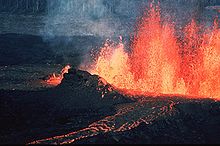Cinder (geology)
Appearance



A cinder is a pyroclastic material. Cinders are extrusive igneous rocks; they are fragments of solidified lava. Cinders are typically brown, black, or red depending on chemical composition and weathering. Cinders are similar to pumice.
Characteristics
The following geologic characteristics define a cinder:
- Uncemented
- Vitreous
- Having bubble-like cavities, called vesicles
- Measuring not less than 2.0 millimeters in at least one dimension
- Apparent specific gravity between 1.0 and 2.0
- Typical cinders are red or black in color.
- Contain numerous gas bubbles "frozen" into place as magma exploded into the air and then cooled quickly.
Uses
Cinders have been used on track surfaces and roads to provide additional traction in winter conditions. Cinders are also employed as inorganic mulch in xeriscaping, because of excellent drainage properties and erosion resistance. In this context, they are referred to frequently with the name "lava rock".
See also
- Cinder block – Standard-sized block used in construction
- Cinder cone – Steep hill of pyroclastic fragments around a volcanic vent
- Cinder track – Race track whose surface is composed of cinders
- Lapilli – Small pyroclast debris thrown in the air by a volcanic eruption
- Scoria – Dark vesicular volcanic rock
- Tephra – Fragmental material produced by a volcanic eruption
- Ye Olde Cinder House – house in West Hallam, Erewash, Derbyshire, England, UK
- Cinderella – European folk tale
